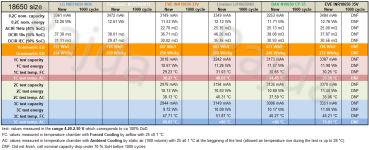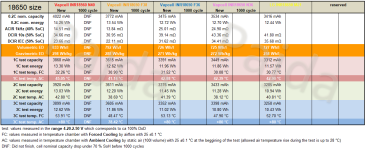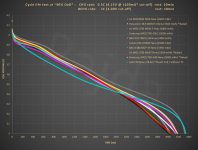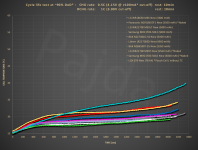Pajda
10 kW
"Standard Power Rate" test (1C continuous discharge)
note: the 1C discharge test is performed at ca 90% DoD (4.15V-3.00V)
Test eqiupment:
- ZKETECH EBC-X0510 (in 2/2024 replaced by BTS-4000)
- NEWARE BTS-4000 test system with T-type thermocoupler module
- BF-2A four-wire cell fixture (10A version with Nickel plated contacts)
- tested in room with relatively stable temperature 20 ±2 °C
Remarks and comments:
- sister thread to the High Power cylindrical cell tests with the same settings Cycle life tests of High Power density cylindrical cells
- the reduction of tested DoD to about 90% (4.15V-3.00V) is based upon requests from the ES community
- from a purely technical point of view, even this small reduction of DoD significantly reduces the differences between high-quality and lower-quality cells.
- it means in practice that almost all cells shows results very similar to each other at 70% DoD or lower (see docware results), but you miss the information that some of high-quality cells perform very well even at 100% DoD (as was shown in 5C @ 100% DoD "torture" test of modern HP cells)
- you will certainly notice the "wawes" in the capacity test at 90% DoD, these are caused by the insertion of a nominal capacity test at 100% DoD. This behaviour is tied with the internal design of HE cells as the HP cells does not shows this effect significantly.
- NEWARE BTS-4000 tester accuracy is ±0.02 % F.S. with the stability ±0.02 % F.S. (much better than ZKETECH EBC-X0510)
- do not much look at the absolute values, particularly at low currents in nominal capacity tests, trends are here important results.
- each 50th cycle is inserted datasheet nominal capacity test with DCIR10s test (single-stage DCIR test with 0.5C load current applied for 10 sec, measured at 50% SoC)
- minimal charging CV phase cut-off current is set to 100 mA due to the ZKETECH testers limitation
____
"Table results and Discharge Voltage Charts" are measured on precision battery tester (not ZKETECH or NEWARE). Those test were performed in temperature chamber under 25 °C, TC is using forced air flow to maintan consistent temp. This 25 °C air flow acts as cooling force on the cell surface, so the measured temperatures under high load will be affected by this.
*Temperature is measured by the miniature 0.2 mm T-type thermocoupler, attached to the cell body using Kapton tape. Some cells are sold as Naked (without tube) and these shows significantly higher temperatures than cells with tube due to the effect of the tube thermal insulation.
18650 format samples
LG INR18650-M36 (X0510 tester, cell supplier: NKON)
BAK N18650CP-35 (X0510 tester, cell supplier: NKON)
Panasonic NCR18650T1 (A20 tester, cell supplier: Vapcell, *Naked)
Lishen LR1865HB (X0510 tester, cell supplier: NKON)
EVE INR18650-33V (X0510 tester, cell supplier: NKON)
21700 format samples
LG INR21700 M58 (X0510 tester, cell supplier: NKON)
LG INR21700 M58T (NEWARE BTS4000 tester, cell supplier: xxx)
Vapcell INR21700 F60 (NEWARE BTS4000 tester, cell supplier: Vapcell)
Lishen LR2170SK (NEWARE BTS4000 tester, cell supplier: Vapcell)
Samsung INR21700 53G(1) (NEWARE BTS4000 tester, cell supplier: NKON)
Samsung INR21700 58E (CC5493F101) (NEWARE BTS4000 tester, cell supplier: NKON)
BAK N21700CD-53E (NEWARE BTS4000 tester, cell supplier: NKON)
BAK N21700CK-55E (NEWARE BTS4000 tester, cell supplier: BTO.pl)
BAK N21700CH-58E (NEWARE BTS4000 tester, cell supplier: BTO.pl)
Temp removed
LG INR21700-M50LT (X0510 tester, cell supplier: NKON)
Lishen LR2170SD (X0510 tester, cell supplier: NKON)
Samsung INR21700-50E(2) (X0510 tester, cell supplier: NKON)
Samsung INR21700-50G(1) (X0510 tester, cell supplier: NKON, *Naked)
Samsung INR21700-48X(1) (X0510 tester, cell supplier: NKON)
BAK N21700CG-50 (X0510 tester, cell supplier: NKON)
21700 format
5300+ mAh samples comparison
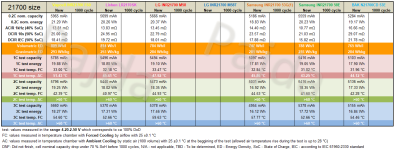
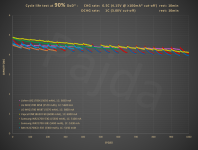
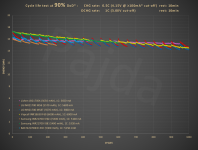
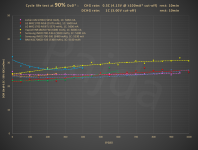
Chart below shows dT = Tend - Tstart (The difference between the cell body temperature at the beginning of the discharge which is RT: 20 °C with up to 3 °C tolerance and the body temperature reached at the end of the discharge). As a Temperature sensor is used NEWARE T-type miniature (0.2 mm) thermocouple, attached with kapton tape.
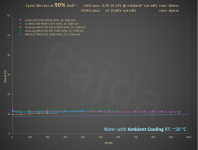
18650 size

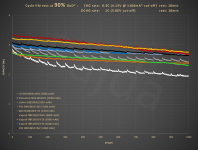
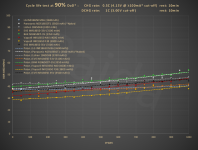
note: the 1C discharge test is performed at ca 90% DoD (4.15V-3.00V)
Test eqiupment:
- ZKETECH EBC-X0510 (in 2/2024 replaced by BTS-4000)
- NEWARE BTS-4000 test system with T-type thermocoupler module
- BF-2A four-wire cell fixture (10A version with Nickel plated contacts)
- tested in room with relatively stable temperature 20 ±2 °C
Remarks and comments:
- sister thread to the High Power cylindrical cell tests with the same settings Cycle life tests of High Power density cylindrical cells
- the reduction of tested DoD to about 90% (4.15V-3.00V) is based upon requests from the ES community
- from a purely technical point of view, even this small reduction of DoD significantly reduces the differences between high-quality and lower-quality cells.
- it means in practice that almost all cells shows results very similar to each other at 70% DoD or lower (see docware results), but you miss the information that some of high-quality cells perform very well even at 100% DoD (as was shown in 5C @ 100% DoD "torture" test of modern HP cells)
- you will certainly notice the "wawes" in the capacity test at 90% DoD, these are caused by the insertion of a nominal capacity test at 100% DoD. This behaviour is tied with the internal design of HE cells as the HP cells does not shows this effect significantly.
- NEWARE BTS-4000 tester accuracy is ±0.02 % F.S. with the stability ±0.02 % F.S. (much better than ZKETECH EBC-X0510)
- do not much look at the absolute values, particularly at low currents in nominal capacity tests, trends are here important results.
- each 50th cycle is inserted datasheet nominal capacity test with DCIR10s test (single-stage DCIR test with 0.5C load current applied for 10 sec, measured at 50% SoC)
- minimal charging CV phase cut-off current is set to 100 mA due to the ZKETECH testers limitation
____
"Table results and Discharge Voltage Charts" are measured on precision battery tester (not ZKETECH or NEWARE). Those test were performed in temperature chamber under 25 °C, TC is using forced air flow to maintan consistent temp. This 25 °C air flow acts as cooling force on the cell surface, so the measured temperatures under high load will be affected by this.
*Temperature is measured by the miniature 0.2 mm T-type thermocoupler, attached to the cell body using Kapton tape. Some cells are sold as Naked (without tube) and these shows significantly higher temperatures than cells with tube due to the effect of the tube thermal insulation.
18650 format samples
LG INR18650-M36 (X0510 tester, cell supplier: NKON)
BAK N18650CP-35 (X0510 tester, cell supplier: NKON)
Panasonic NCR18650T1 (A20 tester, cell supplier: Vapcell, *Naked)
Lishen LR1865HB (X0510 tester, cell supplier: NKON)
EVE INR18650-33V (X0510 tester, cell supplier: NKON)
21700 format samples
LG INR21700 M58 (X0510 tester, cell supplier: NKON)
LG INR21700 M58T (NEWARE BTS4000 tester, cell supplier: xxx)
Vapcell INR21700 F60 (NEWARE BTS4000 tester, cell supplier: Vapcell)
Lishen LR2170SK (NEWARE BTS4000 tester, cell supplier: Vapcell)
Samsung INR21700 53G(1) (NEWARE BTS4000 tester, cell supplier: NKON)
Samsung INR21700 58E (CC5493F101) (NEWARE BTS4000 tester, cell supplier: NKON)
BAK N21700CD-53E (NEWARE BTS4000 tester, cell supplier: NKON)
BAK N21700CK-55E (NEWARE BTS4000 tester, cell supplier: BTO.pl)
BAK N21700CH-58E (NEWARE BTS4000 tester, cell supplier: BTO.pl)
Temp removed
LG INR21700-M50LT (X0510 tester, cell supplier: NKON)
Lishen LR2170SD (X0510 tester, cell supplier: NKON)
Samsung INR21700-50E(2) (X0510 tester, cell supplier: NKON)
Samsung INR21700-50G(1) (X0510 tester, cell supplier: NKON, *Naked)
Samsung INR21700-48X(1) (X0510 tester, cell supplier: NKON)
BAK N21700CG-50 (X0510 tester, cell supplier: NKON)
21700 format
5300+ mAh samples comparison




Chart below shows dT = Tend - Tstart (The difference between the cell body temperature at the beginning of the discharge which is RT: 20 °C with up to 3 °C tolerance and the body temperature reached at the end of the discharge). As a Temperature sensor is used NEWARE T-type miniature (0.2 mm) thermocouple, attached with kapton tape.

18650 size



Last edited:








